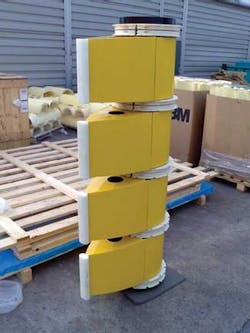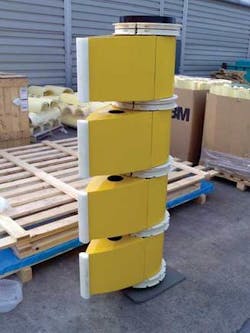Riser fairings bring improvements in VIV, drag suppression
The Riserfin fairing launched by Trelleborg Offshore at this year’s OTC combines the benefits of efficient suppression of VIV - vortex induced vibration - with minimal drag. These properties are significant to both drilling and production risers deployed in deep water.
On trips between well locations, drillships can save valuable time if they move with the riser still deployed. But the deeper the water, and the longer the riser, the greater the drag, so that in extreme cases the vessel may achieve minimal movement even though it is using full power. Technology for minimizing riser drag can therefore contribute to reducing drillships’ non-productive transit time.
For a production riser the scenario is somewhat different. Once deployed, such a riser is expected to stay in place for the duration of the field’s production life, which in these days of enhanced recovery techniques, may be considerably longer than originally envisaged. Minimizing the drag reduces the loads on the riser and, via its terminations, to other production system components. The suppression of VIV minimizes fatigue effects to which the riser is subject through its exposure to currents, prolonging its integrity and avoiding or deferring the costs associated with riser replacement or repair.
In addressing deepwater riser challenges Trelleborg first took up VIV. This phenomenon arises as the flow of water around a riser leads to the shedding of a series of vortices which exert alternating forces on either side of the riser, causing it to vibrate. If the frequency of vortex shedding coincides with the natural frequency of the riser string, resonance occurs which can cause vibration to build to potentially destructive levels.
In the late 1990s, Trelleborg developed an effective solution for suppressing VIV based on helical strakes fitted around the riser. In the process it developed a good understanding of the interactions between currents, riser, and strakes.
“We’re known for our systematic approach,” says David Somerville, group design engineering manager in Trelleborg Offshore’s technology department. “We like to know what our products are doing.” This understanding served it in good stead when, three years ago, it decided to tackle the challenge of riser drag.
While helical strakes had been identified as the solution for VIV suppression, with respect to drag minimization, fairings were found to offer a better answer. Unlike strakes which are fixed to the riser, fairings respond to the direction of the current flow by rotating around the riser.
As in its work on VIV, Trelleborg approached the development of the Riserfin using a combination of computational fluid design work and wet tank testing. The work was conducted at the Memorial University and the Institute of Ocean Technology, both in St John’s, Newfoundland.
Based on aerodynamic technology, the Riserfin has a cross-section similar to an airplane wing, allowing the water to pass the surface cleanly, with limited generation of vortices. It has a corded length of 2D - that is, the length from the front of the pipe to the back end of the fairing is twice the pipe diameter.
Tank testing was carried out with a 12.75-in. (32-cm) diameter pipe equivalent to one-quarter scale of a drilling riser. Its performance was assessed against bare pipe with a rough surface. Tests were configured to represent the full range of current speeds and natural frequencies likely to be met on a live project.
Results showed that in a worst case the pipe fitted with Riserfin vibrated by less than 10% of the pipe diameter, equivalent to 90% VIV suppression, and had a drag coefficient of less than 0.66. Its VIV suppression efficiency was comparable with that of 5D pitch strakes but the drag coefficient for the strakes, at 1.1-1.2, was significantly higher. The drag coefficient for 16D pitch strakes was 1.4-1.6 and for the bare pipe 2.5.
Riserfin fairings can be supplied in polyethylene, GRP, or other materials - the choice depends on the conditions in which they are to be deployed, Somerville says.
Typically fairings are fitted in any number between two and five on each riser section.
Though vibrations are minimized, they are never entirely eliminated, and resonance can be caused especially when two fairings are placed close to each other. For this eventuality Trelleborg has developed a decorrelation clamp which is typically fitted between each pair of fairings. The clamps prevent the residual vortices from vibrating in phase with each other and thus becoming significant forces, Somerville says.
In the course of the Riserfin development, BP and ExxonMobil, which were working together on a deepwater project, approached Trelleborg with a request to become involved. The Riserfin technology has since been qualified by the two oil companies.
The industry is also beginning to appreciate the benefits of technologies for improving the performance of deepwater risers. In 2005, when offshore activities in the Gulf of Mexico were widely disrupted by Katrina and other hurricanes, many drilling operations also had to be halted as strong currents made it impossible to control the riser. People began to realize that the extra time it takes to mount fairings when deploying a riser are likely to be more than offset by increased uptime, Somerville says.
For more information contact David Somerville, Trelleborg Offshore. Tel +44 1695 712 061, fax +44 1695 712 111, [email protected], www.trelleborg.com/offshore

